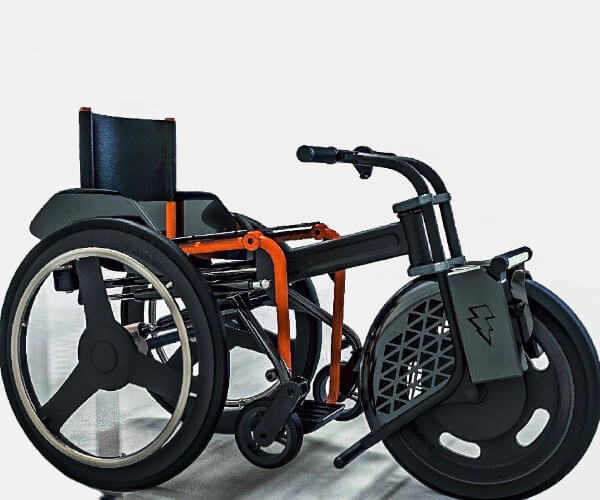On March 8, 2020 Égalité association launched a donation crowdfunding campaign on the Produzioni dal Basso platform with the support of Banca Etica to finance the no-profit industrial production of the Smart Wheelchair. This will be implemented in Italy as soon as possible on the basis of a project that has already been defined and validated.
The Smart Wheelchair is composed of:
– a superlight wheelchair in titanium. Intelligent since it is equipped with suspensions that alleviate rough roads and street spots, with a lifting system that enables users to overcome the ‘invisible line’ of counters (bars, offices, public office windows);
– a front wheel with an electric motor and handlebar, which can easily be attached to and detached from the chair with just one hand and that transforms into a three-wheeled electric bike. Without compromising driving ease and safety.
The Smart Wheelchair guarantees personal autonomous mobility, it is agile and sustainable. Made in Italy, top quality bio-compatible materials and accessories, traceability with blockchain system and assistance guaranteed. Very advantageous prices – nearly at cost – thanks to the no profit approach and the simplicity of the project, based on cycling standards.

Give autonomy to those who need it
‘Give autonomy and reduce barriers for persons with motor disabilities’ is the idea at the basis of the Smart Wheelchair project. In Italy as well as in many other countries, architectural barriers are still ubiquitous.
The Smart Wheelchair represents the first response to the question ‘what can we do to ease the difficulties of those who can’t walk’. The solution is to overcome the obstacle of those who cannot use an electric bicycle or kick scooter, while having the desire and the right, without discrimination.
The idea of the gift was expressed from the very beginning, in the efforts made by volunteers who worked and invested their own resources and materials in the project. And it continues in the logic of offering the Smart Wheelchair at its cost, as well as in applying the basics of the project in other countries. Persons with motor disabilities all over need simple solutions to live and move around.
Don’t hesitate, all it takes is a click! https://www.egalite.
É-TR, the wheelchair trike
The manual wheel chair is without a doubt the one most used, to allow movement for those who have the strength to turn the wheels and to push the weaker ones. The latter, whenever possible, also use electric wheelchairs which nonetheless, due to the heavier weight (up to 150 kg, as opposed to 10-15 kg of a manual one) and size, further limit access and transportation. Impossible to load on vehicles that are not specifically equipped or on elevators, too wide and deep for the majority of domestic elevators.
É-TR is Égalité’s trike. A wheel with an electric motor that is easily hooked to the manual chair and transforms it in an ‘electric tricycle’ to drive indoors and outdoors. It is equipped with a handlebar with accelerator and disk brakes. This solution offers several advantages:
– the trike can be hooked to the chair only when it needs to move about, without altering the weight and volume of the chair after unhooking. It is light and can be easily loaded onto cars, trains, planes;
– the size of the wheel (20’) and the technology used ensure that it can be used efficiently and safely, and it is stable, especially when dealing with potholes or interruptions (such as interstices between platform and subway or trains);
– the hooking/unhooking method is simple, instantaneous and effortless. Thus, the electric wheel can be unhooked whenever it is not needed to move from one place to another.
Objectives, to promote autonomy and sustainable mobility for those with problems moving around.
É-GT, the ‘Gran Turismo’ wheelchair
The second project developed by Égalité concerns the ‘Gran Turismo’ wheelchair, the É-GT. A super-light and solid wheelchair but above all an intelligent wheelchair, to the extent that it meets the unexpressed (or unheard) needs of the many ‘beseiged’ of the planet:
1) absorb the stress that the chair undergoes on uneven pavements (such as holes, gravel, tiles and cobblestones, steps and sidewalks). Since said stress inevitably makes itself felt along the spinal cord (already subjected to stress caused by the sitting still position) we are studying several possibilities including base solutions (elastomers) and suspensions (passive and/or active).
2) raise the seat, at least a little bit, while not in movement, easily. This will reduce that average of a meter in height between the person who is seated (with no possibility of getting up) and instead the person who is standing up. In this case as well, this is not a revolution but a small innovation in the hopes of better social integration and less neck strain for those who are always looking upwards, and those who instead must bend over or sit in order to talk face to face.
Objectives: reduce trauma to the spinal cord for those who live and move about in a wheelchair; facilitate interaction with those who find themselves ‘on a raised level’ with respect to those who are seated.
